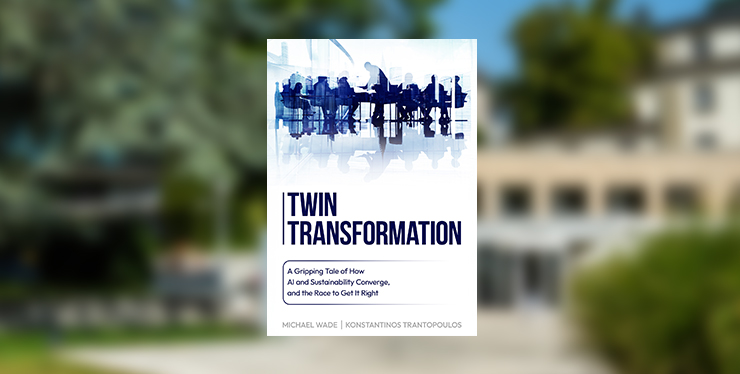In April 2016, around 60 executives attended an IMD Discovery Event to discuss pricing excellence from different perspectives and to explore recent case studies from both B2B and B2C markets.
While organizations might think they understand competitive pricing, potential sales are often lost because of price competition. The challenge that most businesses face is that they cannot afford to adopt a lowest price strategy. To compete successfully in today’s global business environment, companies need to achieve pricing excellence.
Google is the world champion of pricing excellence. It is able to ascertain from its customers how much they are willing to pay and adjusts its pricing to reflect this. This is the essence of the pricing excellence model. The ultimate goal is to uncover and capture the value that is created for each customer.
To succeed in pricing excellence, companies need to develop a set of organizational capabilities that are not discussed in books on pricing and not generally well known because no one is responsible for them. In order to develop a pricing excellence culture, it is crucial to understand these four capabilities:
- Customer data and insights: Understanding what customers really want and how much they are willing to pay for what they want
- Economics: Understanding both the internal economics of the company and the economics of the market
- Pricing management: Setting the right price and making sure that your discounting policy makes sense
- Pricing psychology: Understanding that it is the customer’s perception of the price that drives the behavior.
One company that clearly knows how to use customer insights to its advantage is Bossard, a Swiss-based fastening technology company that sells screws, nuts and bolts to companies such as John Deere and Tesla. In a hugely competitive market, it realized that the only way to stay alive was to capture more value and to price its products according to how much they are worth to the customer.
Having discovered that its customers’ employees were spending more time manually lubricating screws than putting machines together, Bossard teamed up with a chemical company to find a way of producing fasteners with a lubricant already applied, thereby capturing significant value for its customers compared with the next- best alternative. Although the lubricated screws are more expensive, the time- and cost-saving is such that customers are willing to pay the higher price.
With an operating margin that is about twice the industry average, Bossard has clearly leveraged its customer insights.
Customer data and insights
In order to capture more value, companies need to understand what their customers really want and their willingness to pay for it. One way customers reveal their willingness to pay is through self- segmenting, i.e. they themselves choose the high- or the low-price offer.
A good example is grocery coupons, which offer discounts on specific items for a certain period of time. Coupons are an excellent way for retailers to generate more traffic and sell inventory but more importantly, they allow customers to segment themselves through their willingness to pay. Often shoppers cannot be bothered to search for and redeem coupons, thereby effectively choosing to pay the full price.
Most companies do not succeed in generating good customer data and insights because greater emphasis is put on product attributes rather than on benefits. While attributes are easier to focus on because they are tangible and measurable, customers do not buy attributes – they want the benefits. For example, customers of Holcim – one of the world’s largest cement companies – are not interested in cement, they want a street, a bridge or a tunnel.
The fundamental insight is going from focusing on attributes to benefits. When identifying benefits, companies should look at ways to relieve (what does the customer hate doing?) and to enable (what does the benefit enable the customer to do?).
Zoots, a dry cleaning service in New England, US offers a list of benefits as long as your arm. With 45 branches in 10 different states, its business model is based on making things simple for its customers. In addition to dry-cleaning and laundering, its services include alterations, shoe repairs, draperies and upholstery. Not only does it offer home delivery and pick up, but many stores also offer a drive-through service with treats for kids and pets. For busy clients, a 24-hour drop-off and pick- up service is available with automated machines and lockers accessible with a credit card.
Pricing economics
According to economists, markets are governed by the law of supply and demand. If a company prices its product high, it will sell less. If a company’s prices are low, it will sell more. These are the basics of the supply and demand curve. Companies never know what their demand curve is going to look like.
From a pricing excellence viewpoint, the challenge is that the demand curve does not capture customers’ willingness to pay more. Although customers may be willing to pay a premium over the market price, companies lose this value if they give a standard list price to all their customers. They would need to have several prices in the market at the same time representing differences in value.
The problem with this method is that customers will observe the multiple prices and choose price over value. To overcome this, companies need to put a smart fence between customers who appreciate value and those who are just looking for a low price. This is one of the most important strategies in pricing excellence – customers who are willing to pay for value should not be offered a low price.
Pricing management
When the benefits and values are not perceived by the customer and the attributes are standardized, goods and services become commoditized. According to Professor Michel, “Commoditization is a bad word. It is procurement’s weapon to make you lower your prices.”
One way to achieve pricing excellence through pricing management is to reduce harmful discounts. According to Professor Michel, there are only two types of discounts: “stupid” ones and smart ones. By eliminating the “stupid” ones, companies can increase their margin by an average of 1%. The problem is that in many cases, the harmful discounts have become part of the organizational culture making it diffi to identify and eliminate them.
If you offer a discount, you need to make it more difficult for customer. Airline tickets are a good example. While most airlines offer discounts, these usually come at a price, for example requiring the consumer to fly during off-peak hours or only being available on certain days of the week. Flights are offered at incredibly low prices to begin with but gradually increase in price as time goes on. Since passengers are often not able to book flights months in advance, they are forced to pay the full price for last- minute bookings, luggage, etc. Another example of “willingness to pay.”
Pricing psychology
There is a tendency to believe that it is the price that drives consumer behavior, but it is in fact the customer’s perception of the price that drives their behavior. Therefore, pricing management is also perception management; it is important to know how people perceive price.
A good illustration of this is a customer showing interest in a car at a showroom. Which model should the salesperson show first – the high-end model or the low-end model? Research shows that customers tend to buy products that are more expensive if they are shown the high-end model first. If they see the low- end model first, they tend to perceive an increase in cost when they are shown the high-end model. Conversely, when they are presented with the more expensive model first, they feel that they are losing value when they see the cheaper model. This is referred to as loss aversion – a tendency for people to avoid losses over gains.
Another aspect of pricing psychology is the “price carrier” i.e. what you put the price tag on. This is important because it is not always possible to put the price on the value you are creating for the customer. For some customers, for example, an important part of the McDonald’s experience is the play area it provides for the kids and the free Wi-Fi, but the fast-food chain only charges its customers for food and beverages.
Another example is Nespresso, which has changed the price carrier from a kilo of coffee to a cup of coffee. Nespresso aficionados, for example, are happy to pay €0.60 for a capsule, i.e. an incredible €140 per kilo of coffee. The price carrier decision is a fundamental part of pricing excellence.
Frequent dilemmas in pricing excellence
In many companies, the full potential of value-based pricing is not exploited because different stakeholders have competing objectives, inevitably leading to pricing dilemmas. Participants identified some of the dilemmas they have experienced in their own organizations:
- Short term vs. long-term customer management
- Discount vs. cash flow
- Price consistency vs. make the sale
- Profit per SKU vs. profit per customer
- Internal vs. external forces
- Profit vs. mission
- Everyday low prices vs. promotions.
Adobe Creative Cloud Is Our Future1
In May 2013, David Wadhwani, Adobe’s senior VP and general manager for digital media, announced that the Adobe Creative Suite 6 (CS6) would be the last release of Adobe’s creative products to be offered with perpetual licensing. CS6 is a powerful software package for graphic designers, webmasters and creative professionals that includes Photoshop, Illustrator, Premiere, InDesign, Lightroom and many more applications for creative work. Instead, all future development efforts would go into Adobe’s Creative Cloud, where the applications would no longer belong to the user; instead, they would be provided by Adobe for a monthly subscription fee.
1- See Stefan Michel, IMD case no. IMD-7-1731.
Creating pricing excellence with new business models: Adobe Creative Cloud case study
Having read and discussed the case study, participants identified what they felt to be the advantages and disadvantages for Adobe of the switch from the standard software package to a monthly subscription fee on the cloud:
Advantages
- Consistent revenue stream
- Customer insight – (Adobe knows what customers use)
- Lower structural costs (Adobe saves on the physical item and retail costs)
- Illegal copies no longer possible
- Better segmentation
- Speed of innovation
- Customer retention
- Barriers to entry (of competitors – all assets are on the cloud).
Disadvantages
- Big financial hit initially (revenue and profit decline)
- Declining share price
- Setting the right price
- Forced connectivity
- Internal resistance
- Can’t charge for innovation
- Loss of customers
- Unhappy customers.
s” (HVA).
With its new business model, Adobe’s focus was on customer retention. Thanks to the data-rich environment the cloud provided, the company had instant access to big data on its customers, enabling it not only to ascertain the features and services they were using but also to study which user actions led to customer conversion and retention – “high value action
Investors were also an important consideration. The switch meant a significant change in Adobe’s revenue model – revenues and earnings per share were expected to be considerably lower – so investors were understandably skeptical. Adobe was even an acquisition target for a while.
Setting the right price was also a major concern – the team had to estimate how many existing customers would remain, how many new customers could be gained, how long they would stay and how often they would upgrade.
Adobe’s Creative Cloud was launched in June 2013 for $49.99 per month with full access to all applications and 20 GB of cloud storage. Product adoption exceeded Adobe’s expectations; indeed customer satisfaction was significantly higher. Value was created for both the customer and for Adobe.
Capture more value
There is no easy answer or quick fix for achieving pricing excellence. However, in order to successfully manage pricing excellence, it is necessary to understand the core capabilities that influence organizational pricing. The most important thing to remember is in order to create more value, a company needs to capture this value in its pricing strategy. Otherwise, the company will always lose customers to low-cost competitors.
Discovery Events are exclusively available to members of IMD’s Corporate Learning Network. To find out more, go to www.imd.org/cln







